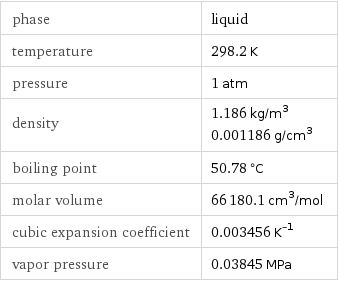Input interpretation

acetyl chloride | phase | liquid
Thermodynamic properties of matter

phase | liquid temperature | 298.2 K pressure | 1 atm density | 1.186 kg/m^3 0.001186 g/cm^3 boiling point | 50.78 °C molar volume | 66180.1 cm^3/mol cubic expansion coefficient | 0.003456 K^(-1) vapor pressure | 0.03845 MPa
Lewis structure

Draw the Lewis structure of acetyl chloride. Start by drawing the overall structure of the molecule, ignoring potential double and triple bonds: Count the total valence electrons of the carbon (n_C, val = 4), chlorine (n_Cl, val = 7), hydrogen (n_H, val = 1), and oxygen (n_O, val = 6) atoms: 2 n_C, val + n_Cl, val + 3 n_H, val + n_O, val = 24 Calculate the number of electrons needed to completely fill the valence shells for carbon (n_C, full = 8), chlorine (n_Cl, full = 8), hydrogen (n_H, full = 2), and oxygen (n_O, full = 8): 2 n_C, full + n_Cl, full + 3 n_H, full + n_O, full = 38 Subtracting these two numbers shows that 38 - 24 = 14 bonding electrons are needed. Each bond has two electrons, so in addition to the 6 bonds already present in the diagram add 1 bond. To minimize formal charge oxygen wants 2 bonds and carbon wants 4 bonds. Identify the atoms that want additional bonds and the number of electrons remaining on each atom: Fill in the 1 bond by pairing electrons between adjacent highlighted atoms: Answer: | |
3D structure

3D structure
Basic properties

formula | CH_3COCl Hill formula | C_2H_3ClO name | acetyl chloride molar mass | 78.5 g/mol
Units
